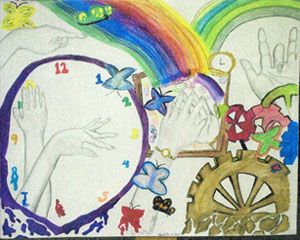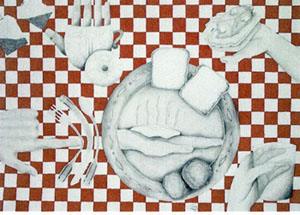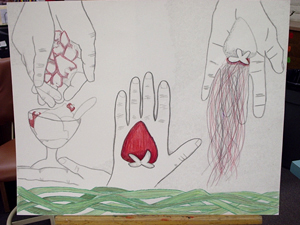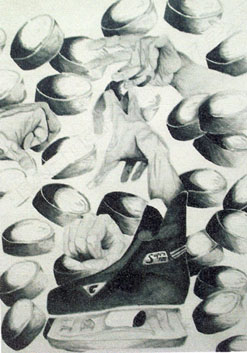
METAPHORIC INTERPRETATION
One of the more difficult tasks for students of this age level and stage of development is to create realistic anatomy. Since the students were able to do this by the end of this lesson, each of them gained confidence in their artwork, and enjoyed the overall process of art making. This project required that they combine this realism into a dynamic surrealistic drawing, which also allowed the teacher to incorporate an art history lesson that was of interest to all of the students. Instead of making a project that was solely based on life drawing, Mrs. T incorporated a whimsical theme that allowed the students a great amount of freedom for creativity. I chose the title “handing in the hands of success” because each of the students was able to do this by the end of the semester, and there was a remarkable amount of progress made by the completion. Many students were unsure of their abilities to create renderings of hands, but even the most unsure were able to hand in a successful drawing.
ASSESSMENT OF STUDENTS'
ART ORIENTATIONS
Hazel:
After observing Hazel’s progress for several weeks, I would most likely define her style of art-making as intuitive. She worked very quickly in many areas of the drawing, and took the most time in creating and shading the hands on her surrealistic drawing. She worked all over the page in this project, and with the exception of the hands, had no previous sketch to help in this creation process. Hazel also constructed this drawing through a set of ever changing plans, which became more and more complex during the course of the weeks she spent working on the project. She tried a variety of solutions to drawings, and often times erased and changed her drawing drastically. Overall, her work has a wide variety of lines and colors, but much of it was hastily added at the end of her project, almost like an afterthought. She was very self-motivated, and worked well on her own without seeking much support from Mrs. T. According to Michael, students with an intuitive approach such as Hazel should be encouraged to attend to details (1983). Hazel’s drawing is relatively detailed, but this is largely due to Mrs. T’s encouragement.

Brittany B
Brittany B.’s art orientation could be considered both mechanical and intellectual. It took her awhile to chose a theme for her project, but when she did she began to brainstorm and think of many visuals that related to her theme and could be tied in with the hands that she created. She began with this strong vision, and had a clear idea of the results that she wanted to produce for her final project. She relied on tools to create her work, which is another indication of the mechanic portion of her art orientation. Brittany probably fits into the intellectual orientation even more than mechanical. She emphasized the subject matter, and her theme was very clear from the beginning. She included a variety of textures, small lines and other details to create this work. She thoroughly planned out each part of her composition, and used complex design elements to finish her work. The contrast of the background to the foreground elements took her the greatest amount of time, and she was very precise when creating these parts. One of Brittany’s foremost problems was that she spent much of the time in class talking with the student sitting next to her. Her work was very well accomplished, but could have probably been better had she worked during the entire class time. Michael suggest that students of the mechanical and intellectual orientations use clay, large brushes or gestural drawing to help evolve expressive or abstract qualities in their work, and to encourage more artistic fluidity (1983).

Brittney O
After observing Brittney O. work through this project, I would define her art orientation as schematic. She had many difficulties completing this project, and used stereotypical and undeveloped schemas to create the hands in her surrealistic drawing. She rushed through much of her project, and her work had very little value in comparison to the rest of the class. The first hands that she drew in this work were very schematic, and she barely used any visual references, even her own hand to create this work. Mrs. T encouraged her to utilize visuals to create draw her hands, and eventually volunteered to pose her own hands as a reference for Brittney O. This helped her to improve on the proportions, although she still did not incorporate much value into her work, and used thick outlines to differentiate her hands from the background space. Brittney O. was easily frustrated with many of tasks that this project included, although she did not result to copying at any point. She had trouble coming up with a theme and when she did, lacked a sufficient amount of detail to complete this theme. She frequently sought help from the instructor, and was easily discouraged. According to Michael, one way to help Brittney O. evolve her artworks is to encourage her to elaborate their works through textures, patterns and shading. The addition of backgrounds may also be a beneficial encouragement to students of the schematic orientation (1983). Mrs. T has had class with Brittney before, and feels that she has more skill and interest in three-dimensional media, such as ceramics.

Cody
Cody’s art orientation was very mechanical in nature. He spent much of his time in class worrying about the small detail of his drawing, and spent little to no time giving the work a finished look, such as smoothly shading the gradations from light to dark in all of the hockey pucks that he included. Cody also had many aspects of the mechanical orientation that became evident while he was creating his work. He frequently looked through classroom books and magazines to aid in his completion of the project. The hand that is coming out of the boot was directly copied from a book in the class, although he relied more on visual observation for the other hands in his drawing. Cody also frequently used his erases throughout the course of his work, and wanted to relay his initial idea faithfully in his drawing. His design was for the most part symmetrical, and he majority of the work is composed of the hockey pucks that he repeated numerous times. Cody also seemed to be very uncomfortable when anyone was observing his artwork. He was very unsure of his abilities as an artist, and although he probably had the skill to advance further with his works, his uncertainty regarding his talents hindered him. Although Mrs. T. believed that Cody was capable of drawing from live models, it was difficult to convince him to try or experiment with this. According to Michael, students such as Cody should be encouraged to use flexible and expressive techniques (1983). This is especially true for Cody since he copied so much of his work, although he had the ability to create these drawings by using live models. Gestural drawings may help to loosen up his marks and to increase his confidence in terms of his artistic capabilities.
